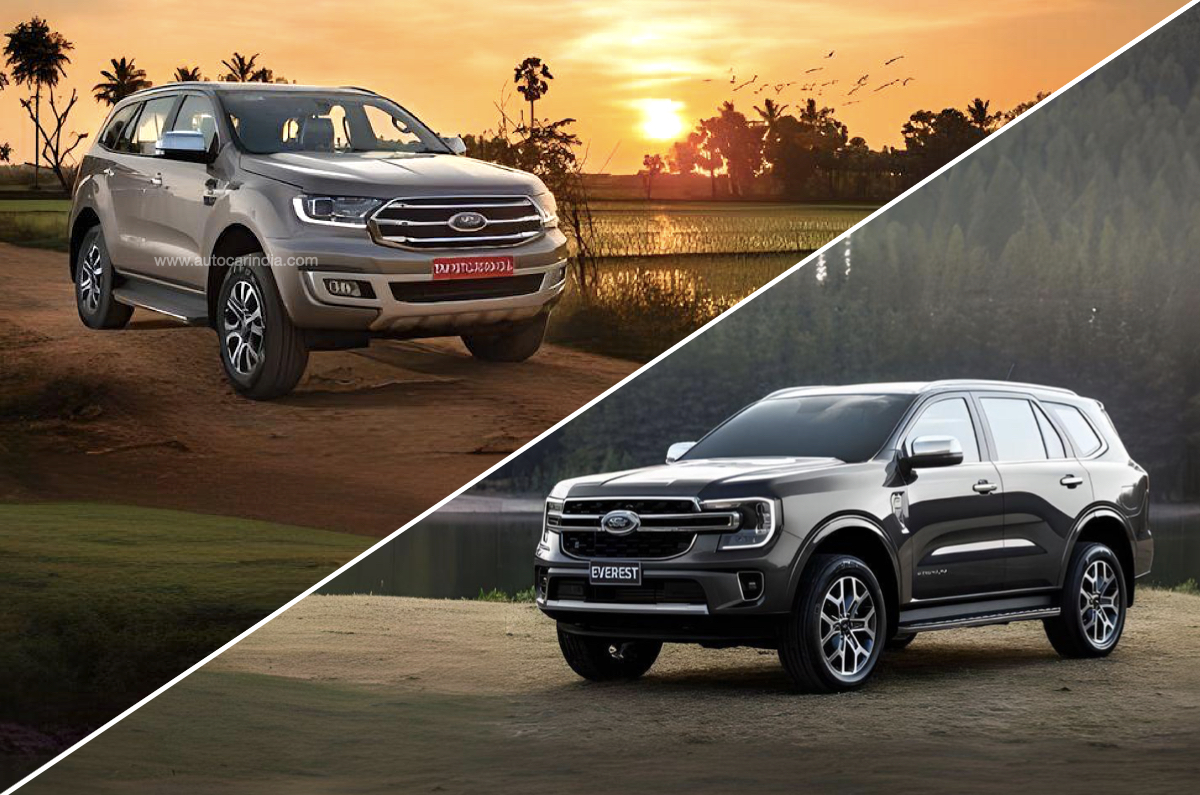
We have already reported that Ford might return to India, and its first model upon return will be the Endeavour. Ford has already filed a patent for the latest-gen Endeavour in India, and the SUV was recently spied uncamouflaged on a flat-bed truck outside Chennai.
This generation of the Endeavour globally debuted in March 2022, but by that time, the company had already exited our market. It’s now expected to go on sale in 2024 itself as an import, and will be a much-needed addition to the full-size SUV segment that has largely been left for just the Toyota Fortuner to dominate. The new Endeavour will be a marked step-up from the last version we had on sale in India, and we take a close look at how exactly it has evolved from its previous generation.
Ford Endeavour old vs new: dimensions
| Ford Endeavour dimensions | ||
|---|---|---|
| Old | New | |
| Length | 4903mm | 4914mm |
| Height | 1837mm | 1842mm |
| Width | 1869mm | 2015mm |
| Wheelbase | 2850mm | 2900mm |
As you can see from the table above, the new Endeavour has only grown marginally in terms of overall length and height, but it is notably wider – 146mm more than before – and the wheelbase has also gone up by 50mm. This should translate to a much roomier cabin, both in terms of breadth and legroom. Do note that the latest Endeavour does share some of its underpinnings with the last version that was on sale in India.
Ford Endeavour old vs new: exterior design
The new Endeavour can certainly be called an evolution of its predecessor – the overall proportions, and its rugged and butch appeal are immediately identifiable, but the details are all new. It gets a boxier front end, there's a large grille featuring a horizontal bar that extends into the new Matrix LED headlights with C-shaped daytime running lights.

While there are similarities with the older model when viewed in profile, the new Everest definitely has a more squared-off design, with a more upright front- and rear-end as well as a stronger shoulder line. At the rear, there are new inverted L-shaped LED tail-lights that extend on to the more upright tailgate and are connected by a black plastic panel. It’s the little details and the sharper lines that just makes the new Endeavour a lot more contemporary.
Ford Endeavour old vs new: interior
The Everest’s interior has also been completely overhauled, with an all-new design and layout. The biggest change is in the orientation of the touchscreen – the 8.0-inch horizontally-oriented screen has made way for a rather huge 12.0-inch screen in its top-spec trim. It extends all the way down to the centre console, but as before, continues to be flanked by vertical AC vents. The stack of physical controls on the dashboard has been trimmed and simplified, and the centre console also has a neater layout.
But while the interior of the previous Endeavour appeared sufficiently sophisticated with soft-touch materials, gloss surfaces and dual-tone black-beige colour scheme, the new Endeavour’s interior is a lot more rugged. It gets an all-black finish, the dashboard has a more upright orientation and elements such as the grab handles, the gear lever and even the steering wheel appear a lot chunkier than before.

It also sees a notable step up on the equipment front – top-spec trim gets ambient lighting, ventilated front seats, a full-digital instrument cluster, wireless charging, automatic climate control, Ford pass connected car tech, a panoramic sunroof, USB charging points in all three rows, 10-way power adjustable driver’s seat, cooled glovebox, power folding third-row seats and a powered tailgate.
Ford Endeavour old vs new: powertrain and specs
In its BS6 guise, the Endeavour was available with a sole engine option – a 170hp, 420Nm, 2.0-litre diesel engine mated to a 10-speed automatic gearbox – in both 4x2 and 4x4 configuration. Prior to the BS6 era, the Endeavour also got a punchy 200hp, 3.2-litre five-cylinder diesel engine or a 160hp, 2.2-litre four-cylinder diesel mill.
The latest Endeavour, meanwhile, gets a range of 2.0-litre and 3.0-litre diesel engines. The range starts with the single-turbo version of the 2.0-litre, four-cylinder unit that produces 170hp, then there’s the bi-turbo version of the same engine that produces 206hp, and finally, the range-topping 3.0-litre V6 turbo-diesel engine produces 246hp and 600Nm of torque. All engines are mated to a 10-speed automatic transmission. The 2.0-litre engines get both 4x2 and 4x4 drive layouts, but the 3.0-litre V6 is only available with a full-time 4x4 system.

As ever, the Endeavour packs in some off-road hardware, including a two-speed electromechanical transfer case featuring 2H, 4H and 4L modes, as well as electronic locking rear differential and six drive modes on the 4x4 models.
Ford Endeavour expected launch and price
Ford is expected to import the Endeavour in limited numbers this year, while it readies its plant for local assembly from 2025. As the plant was already producing the previous Endeavour, retooling it to produce the new model should be relatively easier. But even as an import, prices for the new Ford Endeavour could still be competitive when compared to its arch rival, the Fortuner, which now costs around Rs 60 lakh for the top variants in some states.
Also See:
Ford Ranger spied in India along with new Endeavour
Ford inches closer to India re-entry, trademarks Mustang Mach-E



